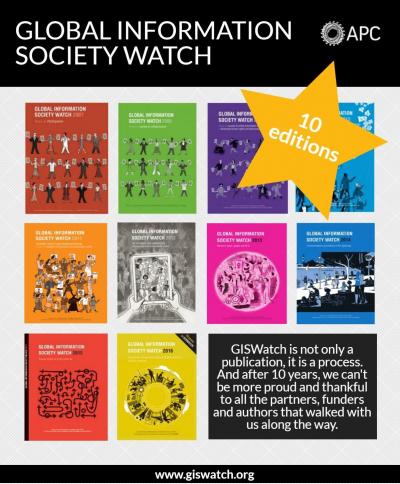Communications surveillance
Action Steps: A decade of civil society advocacy in the information society

The purpose of this review was to look back over the past decade of country reports published in Global Information Society Watch (GISWatch) and attempt to identify trends in civil society perspectives on what needed to be done to create a people-centred information society. The period for analysis was, more accurately, just over a decade: 2007-2017, during which a GISWatch report was produced each year – a total of 11 reports.
GISWatch: An annual snapshot of the information society, 10 years running
Global Information Society Watch (GISWatch) has reached its 10th edition, providing the international community with yearly reports on the state of the information society from the perspective of local civil society organisations and experts from all around the world.

Credits
Global Information Society Watch 2014
Steering committee
- Anriette Esterhuysen (APC)
- Loe Schout (Hivos)
Coordinating committee
- Monique Doppert (Hivos)
- Valeria Betancourt (APC)
- Mallory Knodel (APC)
Project coordinator
- Roxana Bassi (APC)
Editor
- Alan Finlay
Assistant editor, publication production
The myth of global online surveillance exempted from compliance with human rights
Organization
Since mid-2013 there have been continuing revelations about the implementation by the United States (US) government of a series of programmes that constitute a system for global mass online surveillance. The initiative involves several agencies, primarily led by the National Security Agency (NSA), in close cooperation with companies that provide services through the internet. The system, which mostly targets foreigners and overseas communications, has affected private communications everywhere, from heads of state to ordinary web users.
Digital surveillance
Organization
This report examines the properties that make digital communication prone to surveillance and provides a general overview of where and how this surveillance takes place. For our purpose here, any internet or phone-based communication is considered to be digital communication, but we exclude from consideration other forms of surveillance such as direct observation or photography.